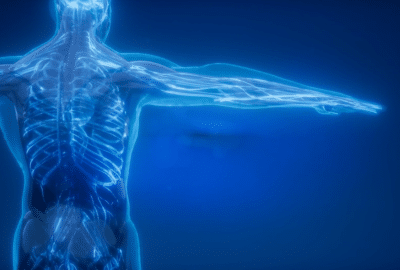A Spin Around the Brain
Friday 30th Aug 2013, 4.45am
This animation is set at the Oxford Centre for Functional Magnetic Resonance Imaging of the Brain (FMRIB). Ossie’s tour around the body demonstrates how neuroscience and physics combine to show how the brain works. Magnetic Resonance Imaging (MRI) scanners give the opportunity to see the brain in action. With stronger magnets, like the one in Oxford, the brain’s structure and function can be seen in great detail. But how does the magnet achieve this?
How does brain scanning work?
Vascular level: When Ossie first enters the body of the person being scanned, he flies into the blood stream. From the very earliest studies of the brain, scientists know that when the brain is active, there is literally a rush of blood to the head. If you could see inside the blood vessels you would see a change in colour from bluish to reddish in areas of high brain activity. This change reflects the increase in oxygenated blood, which is red.
Atomic level: When a person lies inside an MRI scanner, all of the protons in their body try to line up with the magnetic field. The same happens when you put a bar magnet near some iron filings. When protons are lined up with the magnetic field, they spin (or precess) around the main axis of the field. This is similar to the rotation a gyroscope makes as it spins around its axis. Protons in oxygenated blood are very organised and spin at the same rate. Compared to oxygenated haemoglobin, deoxygenated haemoglobin is slightly magnetic. This means that protons in deoxygenated blood are not as well organised in their spinning. This difference between the organised spinning in oxygenated blood and disorganised spinning in deoxygenated blood is detected in the signals recorded from an MRI scanner.
How is brain activity detected?
When a brain area is active, the brain cells (neurons) communicate with each other through very fast electrical impulses called action potentials. This activity uses up energy and oxygen in the blood, and to meet this demand oxygenated blood rushes to the area, displacing the deoxygenated blood. Because of the differences in the proton spinning, the MRI scanner can measure this change in blood flow and show precisely where the oxygenated blood is going. With stronger magnets, blood flow changes can be measured more sensitively and pinpointed more accurately.
Is MRI safe?
MRI scanners contain a very large magnet. The strength of the one at the FMRIB Centre and shown in the animation is 7 Tesla, but normal MRI scanners in hospitals are 1 to 3 Tesla. Scrapyards use 1 Tesla magnets to pick up cars or large pieces of metal. A magnet of 7 Tesla could easily pick up a double-decker bus. It will also attract much smaller metal objects, so these are left outside a scanning room. Anyone being scanned is thoroughly checked for metal so it is safe for them. Now that MRI is commonplace, modern surgical implants are often made of materials that are safe to scan, but checks are still made on everyone.
Different bits of the brain do different jobs.
Before MRI scanners were used to study the brain, the only way to show that a brain area was involved in a particular function was to study the effects of brain damage or diseases. Scientists mapped the brain to show that damage to different areas resulted in different problems. For example a doctor, Paul Broca, studied a patient who could only say the word “Tan”. The patient had damage in the left side of the front of the brain, which Broca claimed was important for speech. A more recent case was that of Henry Molaison, who had brain surgery to remove two small structures in the brain known as the hippocampi. After surgery, Henry could not form new memories, but still had those made before his surgery. Scientists concluded that the hippocampi must be crucial for remembering new events. These studies were invaluable, but relied on chance occurrences of brain damage or disease in a small number of individuals. MRI allows scientists to study many more people and observe functions as they happen.
What can MRI be used for?
Functional MRI allows scientists to watch the brain in action. They can study the brain working in newborn babies and children, in healthy adults and in people with problems that affect their ability to move or see, to speak, to remember or to learn. They can see how the brain changes when it learns a new skill, such as reading or juggling, or how it compensates when someone recovers from brain damage. Brain surgeons can use MRI scans to help them plan surgery by seeing precisely which areas of the brain people use to produce speech or move.
Do we only use 10% of our brain?
There is an urban myth that we only use 10% of our brain. The origin of this is unclear. It may come from reports of some rare individuals who function apparently normally, despite having very little brain tissue due to severe hydrocephalus (increased pressure on the brain). Alternatively, the myth may arise from a misinterpretation of the idea that different parts of our brain do different jobs, so we are only using a few areas at any one time. One of the many things that have been learned from brain imaging studies is that there is no part of the brain that does nothing. Even when we are apparently ‘doing nothing’, for example resting, our brain is actually still very busy. Despite weighing only a small percentage of our total body weight, the brain consumes about a quarter of our total energy.
Can scientists tell what you are thinking?
MRI scanners cannot show the content of your thoughts but they can show which part of your brain you are using. Because scientists know the function of many parts of the brain, they might be able to have a guess as to what you are thinking about.
Scientists are beginning to perform ‘mind reading’ with MRI scanners using computer programs. For example, if we repeatedly record brain activity while someone is watching a series of images, the computer programs can ‘learn’ which images evoke which patterns of brain activity. Then, when a new image is presented, the computer can accurately reconstruct the new image, based on the pattern of brain activity. This is a long way from the kind of ‘mind reading’ that features in sci-fi movies, but could have potential applications in lie-detection or in running brain-computer interfaces for people who are unable to communicate verbally or physically.
Further information:
Teaching Resources:
KS4: Watching the Brain at Work
KS5: The Plastic Brain (contact us)
Find out more:
TED talks on understanding the brain
Wellcome Trust ‘Big Picture – Inside the Brain





